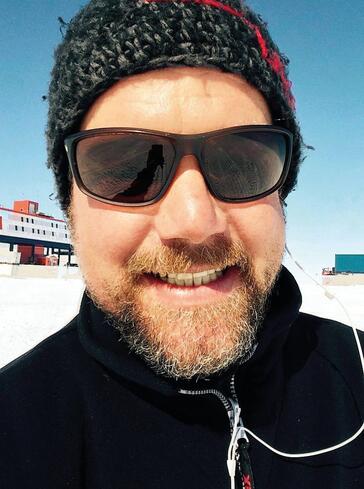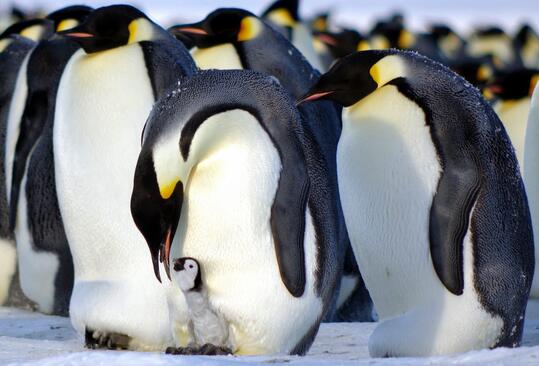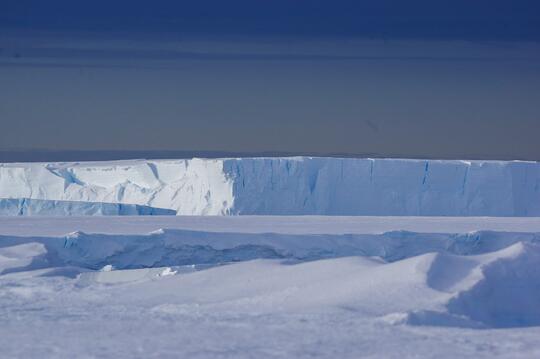corpuls on ice
It is pretty much a tradition: Every year an advertisement appears in the medical specialist newspaper “Das Deutsche Ärzteblatt”: The Alfred Wegener Institute Helmholtz Center for Polar and Marine Research (AWI) is looking for a doctor with a sense of adventure. With the will to go to one of the most hostile areas on this planet for 14 months – nine of them in absolute isolation. Six in the dark.
We are looking for a doctor as station manager and medical supervisor for the new winter team at the only German research station in Antarctica, the Neumayer Station.
"I've stumbled across the ad several times ... and at some point I thought to myself: "Just try it!" says Tim Heitland. He is a thoroughbred doctor, surgical consultant, specialist in visceral surgery and proctologist. Additionally the native of Munich also holds the qualification for emergency medicine. So technically very well qualified. “The nerves only came after the acceptance by the AWI and before going to Bremerhaven for preparation phase. From time to time I had doubts as to whether it was a smart decision..."

The preparation phase. This is probably the most important thing for a stay near the South Pole, especially for winter. Antarctica is the driest and coldest continent on our planet. The temperatures only reach values around freezing point in the warmest month of January in the west and are otherwise far below the annual average of -55° C. The reason for this is the flat angle of the sun's rays. The little solar energy that arrives in Antarctica is also reflected by the snow – simply put: it's cold. Always.
Add to that raging strong winds. In some areas wind speeds of over 300 km/h were measured on 340 days of the year. For comparison: Hurricane Katrina, the storm that devastated large parts of the southern United States in 2005 and is considered one of the most devastating natural disasters in history, peaked at "only" 280 km/h.
Neumayer III, the third Neumayer station of the AWI, is located in a more temperate climate on the Ekström Ice Shelf. Nevertheless: “The memory of cold, extreme cold, really extreme cold, and again just really cold, remains," wrote Tim Heitland at the end of his last stay on Neumayer III in the (absolutely worth reading) blog "AtkaX-press.“ The training lasts four months. Based in the Bremerhaven-Reinkenheide Clinic. Here everything is organised that is required to live as a community for 9 months on roughly the size of a quarter of a football field. Without any outside help. “All planes and helicopters will be relocated at the beginning of the Antarctic winter – to the Arctic. That alone is a two-week flight. And even if we had an airplane, the weather conditions are so bad there in winter that flying is out of the question.“ In the event of an emergency, however, the doctor is not entirely on his own. “All team members received intensive training in Reinkenheide for two weeks before leaving. So everyone can lend a hand. In addition, the equipment on Neumayer III really is first class.“ A full operating theater, C-arm, dental x-ray, even a video laryngoscope, corpuls3 and corpuls. mission LIVE. “Out here, on the eternal ice, we depend on the possibilities of telemedicine. We have used this in the past with another system on corpuls 08/16, but corpuls.mission LIVE is in a different league. How elegantly the system from corpuls3 and corpuls.mission LIVE is integrated is great. If the worst comes to the worst, we have professional help on Neumayer III from the Reinkenheide Clinic within seconds. Our colleagues in Bremerhaven see exactly what we see and that helps a lot.“


Accident prevention is also extremely important: “We are trained in fire fighting. But we don't just spray a powder extinguisher around, we do it properly in the Navy's damage defence training centre.“ The training with the navy makes sense, as you can imagine Neumayer III like a ship. But Neumayer III is more like a spaceship on its way to Mars. Without the possibility of heading for a port and offloading a patient.

Other institutions have also noticed this. “As a doctor, I don't just sit around when there is nothing happening and nobody to cure. We are working on a study launched by the Ludwig Maximilian University in Munich, the Charité in Berlin, the University of Pennsylvania and NASA, supported by DLR and AWI. This involves longterm space travel, such as an expedition to Mars, and the following questions: What influence does isolation have on psychology and physiology? How does the immune system react in this low-stimulation environment, like the vegetative nervous system? Are the cognitive abilities, the ability to react, three-dimensional thinking and the ability to orientate oneself declining? And, of course, what is the dynamic within the group? For the study, we take blood, saliva and all kinds of other samples and freeze them. Cryopreservation is less of a problem here. We wear activity trackers and regularly have 24-hour ECGs. We even have the original NASA simulator for docking modules to the International Space Station ISS here. Which by the way is not that easy. There are also numerous psychological questionnaires as well as preparation and follow-up with examinations in Berlin. In its isolation and with our small team, Neumayer III is ideal for something like this. Much better than, for example, the USA stations. There are just too many people there in winter. Sure, you could just lock nine people in a container at the DLR in Oberpfaffenhofen and say: "We won't open the door for a few months now", but basically everyone knows that in an emergency, the door would be opened. We have no such door on Neumayer III.“
Comparing Neumayer III to a space station is not that far-fetched. “There are around 80 stations in Antarctica, less than half of which are occupied in winter.
Our closest neighbour, the South African station, is around 250 kilometres away. You can drive that in Germany in a few hours. For us it's a three-day trip in the Snowcat – in good weather. Nevertheless, we are all in contact, we send each other virtual postcards over the internet and we have the tradition of the "48-hour film festival.“ Here, a station is given five terms relating to the animal world – plants are not included – and then they have to make a film about it within 48 hours."

As the station manager, I am also responsible for the safety of the team and the station, for fire protection including exercises, the marking of the routes and even for monitoring the quality of the drinking water. There is also organisation and public relations work. The only thing I don't have to do is cook."
Catering is also a place where the similarities between the space stati-on and Neumayer III end. “Basically we have everything here that can be made durable in any way. As with the study samples previously mentioned: things freeze quickly here. Fresh vegetables, fruit and the like are particularly problematic. We recently had a greenhouse – ‘Project Eden’, but it wouldn't be Antarctica if it was that easy." Still: The alternative in space would be protein paste from a tube. For 416 days.
"Do you know what strikes you most when you come home after 14 months?"asks Heitland. “Smells. In Antarctica you have no smells, except in the station. But the smell of plants, nature, the sea or – on the other end of the spectrum – a city with its exhaust fumes. It doesn't exist there. And the colour green. The Antarctic has many variations of colours, it is a wonderful, unique place – but there is no green. And very few people. You notice that when you get off the plane at home. And it hits you like a slap in the face. But after two weeks you acclimatise again."

Interested? Then check out the advert in the Deutsches Ärzteblatt. Even if you work as a carpenter, cook or in another skilled trade and work emergency services on the side, your chances are good. Take a look at www.awi.de.
Photos: Tim Heitland, S. Christmann, AWI
These articles might also interest you
 corpuls in use
corpuls in useStarcode - Emergency on board of "Mein Schiff 2"
On the "Mein Schiff 2", the medical team is always prepared for emergencies, despite the holiday mood. corpuls in use
corpuls in useDOWN UNDER – Queensland Ambulance Service
3,800 paramedics are on duty every day with state-of-the-art equipment in often extreme conditions for almost 5 million residents. corpuls in use
corpuls in useEmergency rescue at the Oseberg oil field in Norway
Why the probability of surviving a cardiac arrest in the middle of the North Sea is almost higher than on the mainland corpuls in use
corpuls in useCompetence Centre for Rescue Services in Peru
With the training of rescue service professionals, the rescue system in Peru and Bolivia is optimised sustainably. corpuls in use
corpuls in useAir Zermatt – RESCUE AT 4,000 METRES
Extreme Alpine Air Rescue - with 11 helicopters, Air Zermatt flies 2000 rescue missions per year corpuls in use
corpuls in usePerfect partners on duty
Revolution in resuscitation: The modular monitoring/defibrillator system corpuls3 can now work synchronously and directly with the chest compression device corpuls cpr. Another step towards the perfect rescue system.










